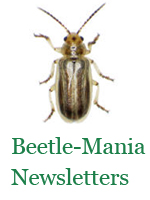Musk Thistle Leaf Beetle
Psylliodes chalcomera (Illiger)
[Coleoptera: Chrysomelidae]
Biology | History | Status | Management | Weeds | Literature | Links
In studies in Europe, eggs are laid from January to June at the base of the plants or in the soil adjacent to the plants. Larvae feed on flowers and leaf buds. Larvae mature by mid-May and pupate in the soil. Adults emerge in early June and feed on the thistle leaves. Females produce an average of 296 eggs and most live a single season. A few individuals lived 20 months and produced eggs in two seasons (Dunn and Rizza 1976).
After investigations in Europe this species was selected as a candidate for further study for the biological control of thistles. Consequently, the biology of this beetle was studied in Italy (Dunn and Rizza 1976).
One release of this leaf beetle was made in Kerr County about 1995. Establishment of this species has not been confirmed.
Until the species can be established there are few guidelines for management. Adult flea beetles and larvae can be collected on the plants and transported for redistribution studies.
The musk thistle leaf beetle feeds on several Carduus species.
Dunn, P. H. and A. Rizza. 1976. Bionomics of Psylliodes chalcomera, a candidate for biological control of musk thistle. Annals of the Entomological Society of America 69(3): 395-398.

